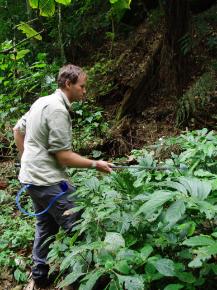Profile
Biography
I am interested in amphibian conservation and in particular the response of populations in unique habitat types, specifically tropical montane systems, to climate change and the subsequent implications for conservation and protected areas. An aim of the PhD is improve clarity of climate projections through improvements to the resolution of the underlying species distribution models. My particular region of interest is East Africa and Madagascar and I have spent time in both areas either co-ordinating conservation projects, training staff or actively carrying out research on the regional fauna. My MSc was in Applied Ecology and Conservation (UEA) and I spent time in tropical island ecosystems in order to determine components of habitat use for endangered geckos.
Career
| 2013–present |
Part-time PhD, University of York |
| 2013–present |
IUCN Amphibian Specialist Group member |
| 2008–present |
Curator of Lower Vertebrates and Invertebrates, Paignton Zoo |
| 2003–2008 |
Zoological Curator, The Living Rainforest |
| 2002–2002 |
Research Assistant, Institute of Zoology, London |
| 2001–2002 |
Assistant Curator, Newquay Zoo |
| 1999–2000 |
MSc, University of East Anglia |
Research
Projects
PhD title: Predictive Modelling for Anuran Responses to Climate Change in Tropical Montane Ecosystems (self-funded)
Supervisors: Philip Platts and Rob Marchant
Advisors: Andrew Hartley (Met Office)
Overview
Climate change combined with habitat fragmentation is becoming recognised as perhaps the dominant threat to biodiversity in the 21st century. Although habitat loss, pollution, over-hunting and other anthropogenic pressures have already exerted a toll on global biodiversity, climate change is likely to exacerbate the situation, pushing many species already on the brink of extinction over the edge into the precipice. Amphibians are a group of animals already undergoing an extinction crisis, with at least a third of species threatened with extinction. Most amphibian species are found within tropical montane ecosystems (c. 47% of species), however these ecosystems are also amongst the most vulnerable to climatic shifts. This vulnerability coupled with low mobility and high philopatry to sites exhibited by many amphibian species suggests that tropical montane amphibians are likely to succumb to climate change.
Species niche modelling using a variety of environmental factors and data from a range of sources (typically including GIS), in order to predict species response to shifts in climatic stratification is a useful tool in climate change. In theory it allows conservation practitioners the ability to take informed action when managing habitats for species. However, many predictions of species response to climate change have been made at a global scale but the effect of scale in bioclimatic modelling receives relatively little consideration, yet as an ecological concept it is essential in explaining the distribution of species. The PhD aims to develop species traits which will encompass rare species and those endemics restricted to montane habitat types. These traits will allow species distribution models to account for ecological realism and ultimately improve projections of extinction risk of amphibian assemblages under climate scenarios. Improved distribution models will also then inform and focus decision on protected areas and use of resources where they will be most effective. This comparative study will utilise two distinct but similar data-sets to search for common linkages in the underlying distribution of anuran species. The diversity of amphibians found in both the Eastern Arc Mountains in Tanzania and the highlands in Madagascar will form the data sets for testing.
Within the sub-Sahara region, both the Eastern Arc Mountains and Madagascar are important areas for amphibian diversity: both regions exhibit extraordinarily high rates of endemism. Madagascar is important biologically due to the degree of endemism exhibited by its herpetofauna and has escaped large-scale, recent amphibian extinctions such as those reported in many other areas of the world and catastrophic declines in amphibian populations as seen in South and Central America have yet to be detected. Regional warming trends for Madagascar have not been widely explored and despite the potential vulnerability of montane assemblages further scientific validation of climate change impact does not appear to be forthcoming. The Eastern Arc Mountains (EAM) support an extraordinary degree of biodiversity. Of 96 vertebrate species endemic to the EAM, 38 are amphibians. Considering their global importance in amphibian conservation, both regions suffer from a paucity of data making the PhD both challenging and essential.
While there have been many studies on vertebrate responses to climate change, very few studies have been published for amphibians despite the clear aims from the IUCN’s Amphibian Conservation Action Plan.
Research group(s)
York Institute for Tropical Ecosystems (KITE)

